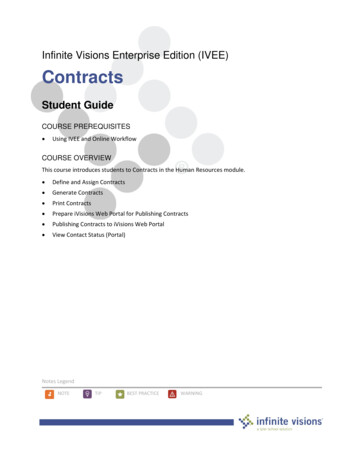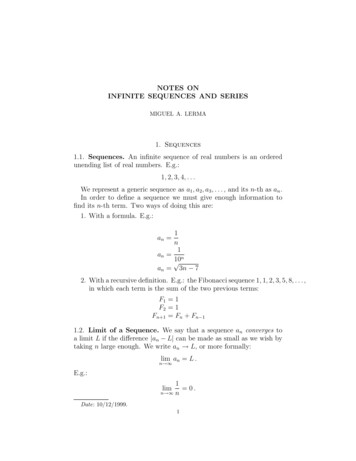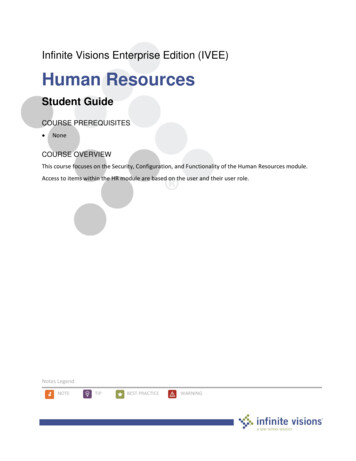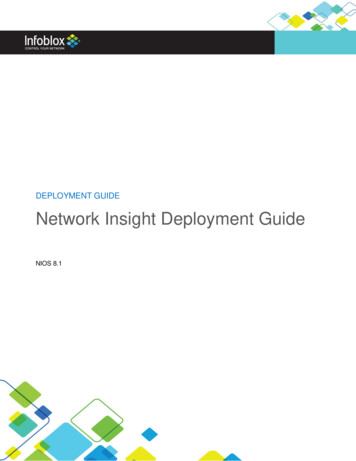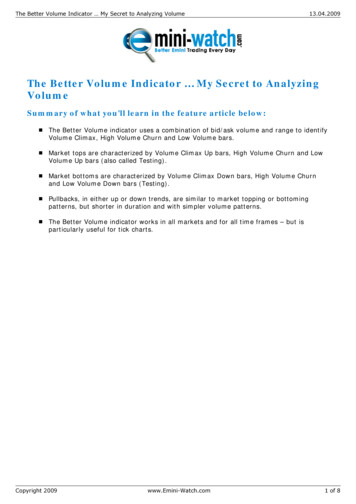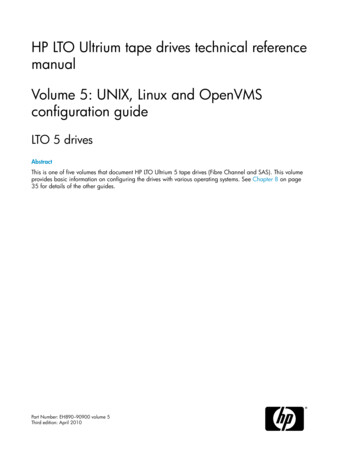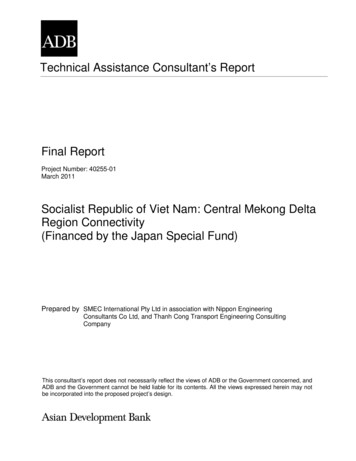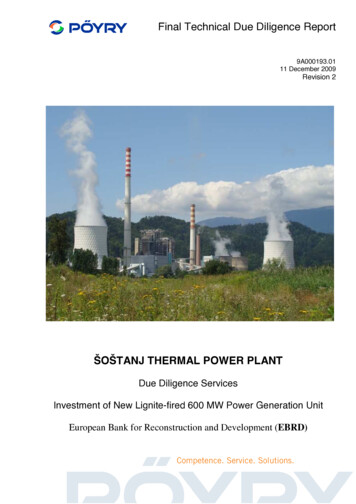
Transcription
Technical ReportInfinite Volume Deployment andImplementation GuideSandra Moulton, NetAppJune 2013 TR-4178Abstract This technical report focuses on NetApp Infinite Volume implementations starting in clustered Data ONTAP 8.2.This report describes in detail how to implement and use Infinite Volume and providesinformation on best practices, operational considerations, and troubleshooting.
TABLE OF CONTENTS1Introduction . 42Overview of NetApp Infinite Volume Overview . 42.13Infinite Volume Components .5General Infinite Volume Features . 63.1Infinite Volume Capacity Balancing .64Infinite Volume Requirements . 75When to Use an Infinite Volume . 86Performance . 876.1I/O Performance of Infinite Volume .86.2Flash Cache Cards and Flash Pool .9Scalability . 97.1Increasing the Size of an Infinite Volume .98Security . 99Configuration and Operation . 99.1Command Summary .109.2Interpreting Space Usage and Savings .129.3Quick Start .139.4Creating an Infinite Volume .159.5Resizing an Infinite Volume.179.6Best Practice Recommendations for an Infinite Volume .189.7End-to-End Infinite Volume Configuration Examples .1910 Upgrading and Reverting . 2710.1 Upgrading to a Newer Version of Clustered Data ONTAP .2710.2 Reverting to a Newer Version of Clustered Data ONTAP .2711 Infinite Volume with Other NetApp Features . 2811.1 Data Protection .2811.2 Other NetApp Features .3112 Troubleshooting . 3512.1 Infinite Volume Shows Sufficient Space But File Write Fails .3512.2 Can’t Change Space Guarantee (Disable Thin Provisioning) .3512.3 Lower-Than-Expected Space Savings .382NetApp Infinite Volume Deployment and Implementation Guide
12.4 Latency Increases For a Couple of Minutes Every Hour .4012.5 SnapMirror Initialization or Updates Failing.4112.6 Attempt to Enable SnapDiff Failing .4112.7 Slower-Than-Expected Performance .4112.8 Space Not Being Used as Expected .4212.9 Location of logs and Error Messages .4312.10Where to Get More Help .43Additional References . 44Version History . 45LIST OF TABLESTable 1) Overview of Infinite Volume requirements. .7Table 2) SVM for Infinite Volume level commands. .10Table 3) Infinite Volume Level Commands. .10Table 4) Commands for compression and deduplication of existing data. .12Table 5) Interpreting volume show savings values. .12Table 6) Infinite Volume quick start. .13Table 7) Supported SnapMirror configurations with Infinite Volume. .30Table 8) How to determine the amount of free space required to change the space guarantee to None. .37LIST OF FIGURESFigure 1) Infinite Volume high-level view. .4Figure 2) Infinite Volume constituent layout.53NetApp Infinite Volume Deployment and Implementation Guide
1 IntroductionCurrent market trends for data storage indicate that file-based storage is the fastest-growing marketsegment in the storage industry. An explosion of unstructured content growth in the market for activedeep archives and content repositories creates new challenges in the storage and retrieval of largevolumes of data. NetApp’s’ solution for this problem is Infinite Volume, which provides a single largecontainer that is optimized for scale and ease of management. Infinite Volume is built on NetApp’s’proven clustered Data ONTAP solution.Notes:1. The same information applies to both FAS and V-Series systems, unless otherwise noted. 2. An Infinite Volume is a single large scalable file system that contains a collection of FlexVol volumescalled constituents.References to an Infinite Volume mean the logical container, not its individual constituents.3. An Infinite Volume includes a namespace constituent and multiple data constituents. The namespaceconstituent contains the directory hierarchy and file names with pointer redirectors to the physicallocation of the data files. The data constituents contain the physical data in an Infinite Volume.References to either the namespace constituent or data constituents mean that specifically, not theentire Infinite Volume.4. References to FlexVol volumes are specific to clustered Data ONTAP 8.2.5. Whenever references are made to SVM they are referring to Storage Virtual Machine which is thelogical container that Infinite Volume resides within.2 Overview of NetApp Infinite Volume OverviewPart of the NetApp clustered Data ONTAP offering, Infinite Volume can store petabytes of data andbillions of files in a single file system. Infinite Volume integrates with NetApp’s proven technologies and products, such as deduplication, data compression, Snapshot copies, SnapMirror replication, andnondisruptive operations. Infinite Volume is designed to address the needs of large unstructuredrepositories of primary data, which are also known as enterprise content repositories. Infinite Volume isfocused on use cases that can be characterized by input/output (I/O) patterns in which data is writtenonce and seldom changed. However, this data is used for normal business operations, and thereforecontent must be kept online for fast retrieval, rather than being moved to secondary storage.Infinite Volume works by grouping storage resources across multiple aggregates and nodes into a singlenamespace and presenting a single file system to the client. It automatically distributes files across thenodes and aggregates within a cluster.Figure 1) Infinite Volume high-level view.4NetApp Infinite Volume Deployment and Implementation Guide
2.1Infinite Volume ComponentsAn Infinite Volume is made of a group of constituents stitched together into a single volume. When anInfinite Volume is created, it automatically creates the following constituents distributed across nodes:-Namespace constituent-One or more namespace mirror constituents-Data constituentsThe namespace constituent contains directory and file names and pointer references to the physicallocation of the file in the Infinite Volume. It is also the junction path, which is the client-accessiblenamespace for the entire Infinite Volume. There is one namespace constituent per Infinite Volume, andby default, it is a maximum of 10TB.The namespace mirror constituent contains an asynchronous volume SnapMirror copy of the namespaceconstituent. It serves two main purposes: backup for the namespace constituent and enabling support fordifferential tape backup by using SnapDiff. There is one namespace mirror constituent for backup of thenamespace constituent. It is replicated every 5 minutes, and is equal in size to the namespaceconstituent.SnapDiff requires that each node contain either a namespace constituent or a namespace mirrorconstituent. Because one namespace constituent and one namespace mirror constituent are alreadycreated by default, adding SnapDiff involves creating additional namespace mirror constituents on eachnode that contains an Infinite Volume data constituent, but that doesn’t contain a namespace constituentor a namespace mirror constituent. By default, the namespace constituent mirrors created for SnapDiffare replicated once a day, but this can be modified to a value larger than 1 hour. The namespace mirrorconstituents are equal in size to the namespace constituent.The data constituents contain the data from files stored in the Infinite Volume. An entire file exists within asingle data constituent. Data constituents are created on each node that has at least one aggregateassigned to the Infinite Volume. Upon Infinite Volume creation, equal amounts of usable data constituentspace are created on each node that contains an aggregate assigned to the Storage Virtual Machine(SVM) for Infinite Volume. Data constituents can grow up to the maximum supported size for the model ofsystem that contains it. For details, see NetApp Hardware Universe.Figure 2 shows the underlying constituents of the Infinite Volume. The blue circles are data constituents,the red is the namespace constituent, and the pink is the namespace mirror constituent.Figure 2) Infinite Volume constituent layout.5NetApp Infinite Volume Deployment and Implementation Guide
3 General Infinite Volume FeaturesInfinite Volume provides a single volume that can store large amounts of data within a single file system.Some of the main features include: Single large container Single file system Single junction path Automatic load balancing of files during ingestNondisruptive scalability; start small grow as needed Up to 20PB Up to 2 billion files Scales across up to 10 nodes in a cluster Automatic capacity balancingProvided by default with clustered Data ONTAP Does not require any additional licensesSupports multi-tenancyAllows multiple SVMs with FlexVol volumes and SVMs with Infinite Volume on the same unifiedscale-out storage clusterSupports storag
For details, see NetApp Hardware Universe. Figure 2 shows the underlying constituents of the Infinite Volume. The blue circles are data constituents, the red is the namespace constituent, and the pink is the namespace mirror constituent. Figure 2) Infinite Volume constituent layout. 6 NetApp Infinite Volume Deployment and Implementation Guide 3 General Infinite Volume Features Infinite Volume .

